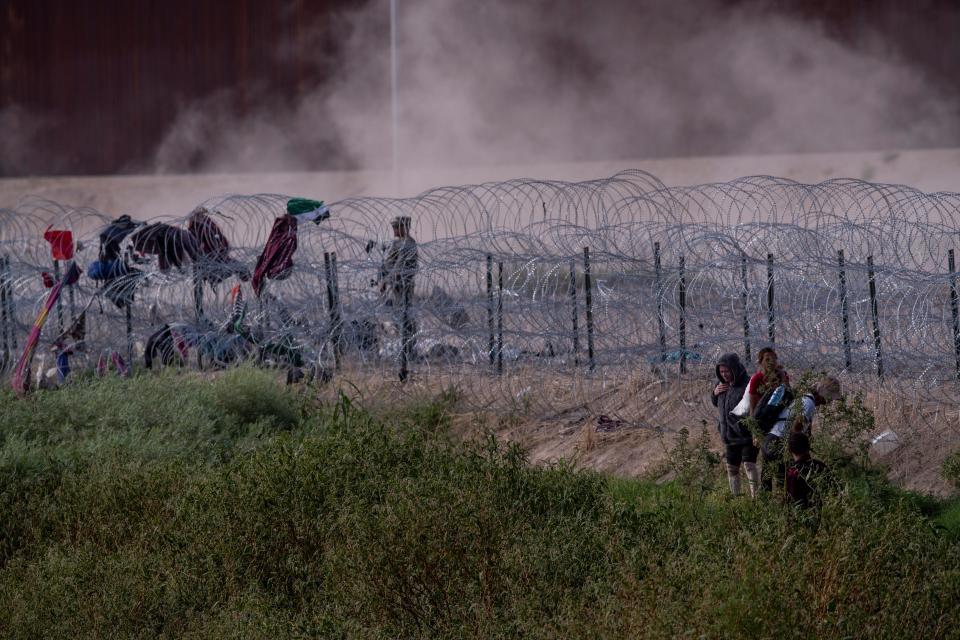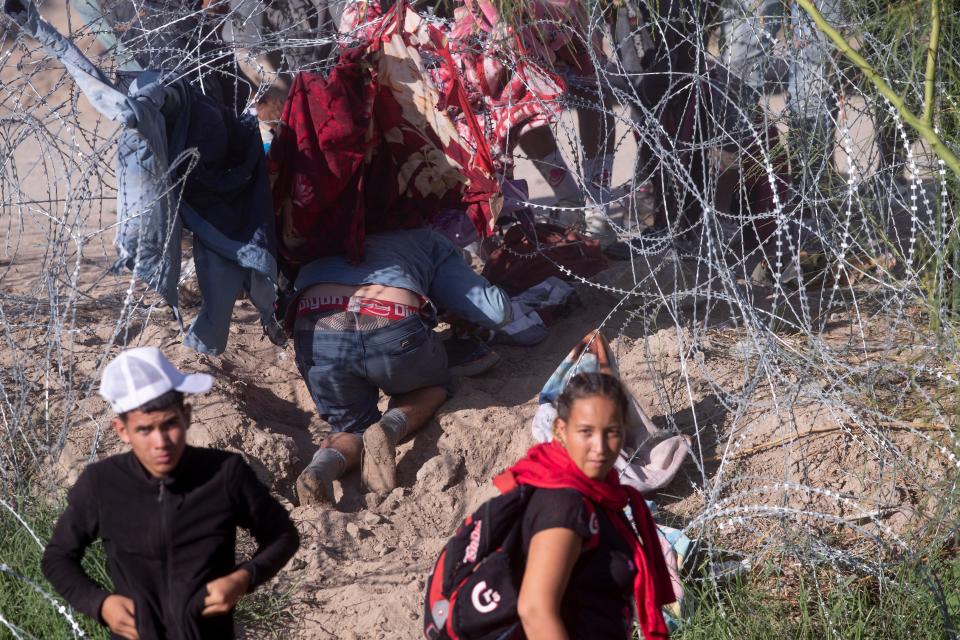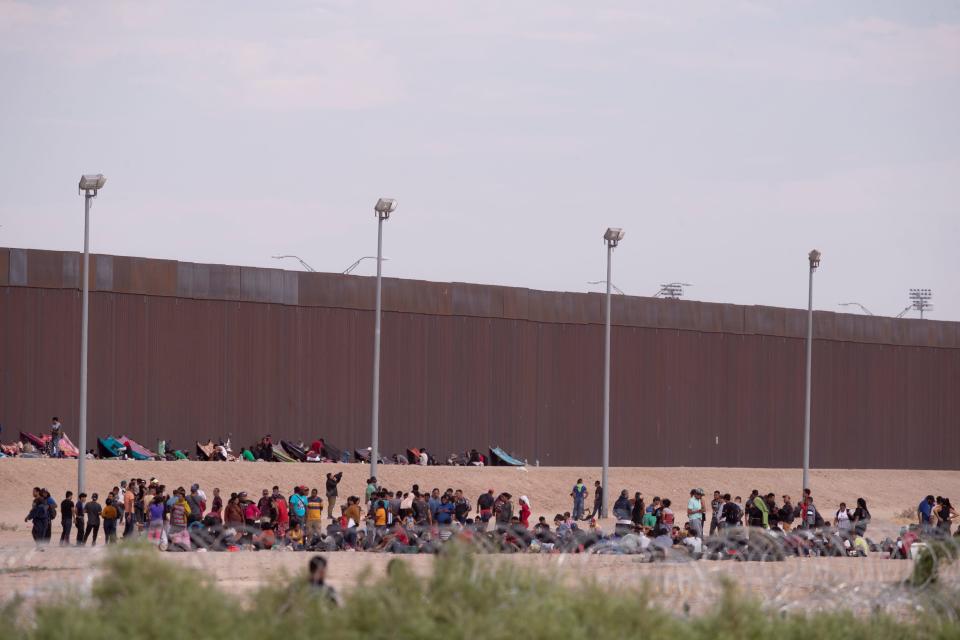El Paso City Council purchases Morehead Middle School to convert to new migrant shelter
The city of El Paso has purchased and turned a vacant West Side school into a temporary shelter for migrants.
The new Community Readiness Center — formerly the vacant Morehead Middle School — was activated on Saturday, Sept. 30, and sheltered a little more than 200 people overnight, a city spokeswoman said on Sunday.
The El Paso City Council has approved the purchase of the former Morehead Middle School — a nearly 19-acre property located at 5625 Confetti Drive — from the El Paso Independent School District for $3.8 million, well below its $10.9 million market value as of February.
The city will pay EPISD just over $23,500 monthly for the property.

"As we all know, the situation is fluid daily and we have become very agile in our ability to adapt and pivot quickly depending on the daily numbers and circumstances," Mayor Oscar Leeser said in an email. "The purchase of Morehead will help in this effort as it provides us with a permanent facility for immediate temporary sheltering and gives us a long-term strategic asset not only for sheltering, but for other city emergencies."
The City Council approved the purchase Sept. 25. A city presentation laid out the timeline for the sale:
Earnest money ($10,000): Five business days after the effective date
Title objections: 10 days after delivery of the title commitment and survey
Inspection period: 90 days after the effective date
Closing date: 15 days after the end of the inspection period
More: El Paso officials worry new rush of asylum-seekers pushing city to 'breaking point'
City Strategic Communications Director Laura Cruz-Acosta said in an email that city staff "is working as quickly as possible to prep the facility for operations."
The new facility will be capable of housing between 400-500 people at a time and will not prioritize one group, such as women and children, over another, she said.
"While the percentage of migrants are predominantly single adults, we are seeing more than 40% are families," Cruz-Acosta wrote. "The city and (Office of Emergency Management's) priority is to provide public safety and care for the wellbeing of our community and that of the migrants traveling through our community; and as such we will provide shelter for those who need shelter."
How many migrants are in El Paso?
The city is still seeing thousands of migrants arriving in El Paso weekly.
The city maintains a Migrant Situational Awareness Dashboard, which provides real-time data on how many migrants are being apprehended by Customs and Border Patrol agents, how many are taking charters out of the city and how many meals are being provided.
For the month, the city has sheltered more than 14,800 arriving asylum-seekers and provided more than 37,000 meals. Late last week, 7,566 asylum-seekers were in CBP custody, according to government figures for that timeframe.
Of 1,614 encounters, more than 1,200 were released to the city, county and local non-profit groups assisting migrants. The city has continually stressed its focus on avoiding street releases and last weekend activated a shelter at Nations Tobin Recreation Center, which is being used to offset the burden on non-governmental organizations until the Morehead facility opens.
However, Cruz-Acosta noted that both facilities could be open at the same time in order to prevent street releases.
Immigration: Biden administration's border policies were working. What went wrong?
"The city team is working non-stop on multiple fronts, as well as collaborating with all our partners to ensure we do not have any asylum-seeker street releases," Leeser said. "Not only is this the humane and the right thing to do, but safe for our community, which is our No. 1 priority."
Despite the increase in migrant arrivals in recent weeks, Border Patrol's El Paso Sector has yet to drop migrants on street corners or bus stations — known as a "street release." Migrants released without orientation by the city, county or a nonprofit often struggle to find shelter, food and transportation out of town.
The last street release occurred in December 2022, according to Border Patrol.
Six charter buses left El Paso by midday Thursday, Sept. 28, carrying more than 250 migrants bound for New York, Denver and Chicago. Those cities have emerged as the preferred locations for migrants requesting a bus ride out of El Paso.

The latest increase of asylum-seekers has been largely unsponsored Venezuelan migrants, which means they have no family to support their travel across the country. And because there are currently no diplomatic ties between the United States and Venezuelans, the repatriations allowed under Title 8 cannot be employed.
"As I have said before, our immigration system is broken," Leeser wrote. "The city of El Paso is a welcoming community, and that makes me very proud, but no community can continue these efforts endlessly."
The mayor said he is grateful federal funds are helping finance local operations so that El Paso taxpayers are left picking up the tab.
"But it is imperative that Congress set partisanship aside and work toward a bipartisan long-term plan to work with other countries in order to create a more manageable, humane and sustainable immigration system for our country," Leeser said.
10 El Paso agencies receiving FEMA funds in latest grant cycle
The Shelter and Services Program was approved by Congress to assist communities on the frontlines of the growing migration crisis. The program awarded $290 million in June, followed by $77 million in August as part of more than $785 million allocated for the program.
"(Shelter and Services Program) grants have provided critical support to communities receiving migrants and the need for this support is ongoing," said Secretary of Homeland Security Alejandro Mayorkas said in a news release announcing the grants Tuesday, Sept. 26. "With this announcement, (the Department of Homeland Security) has completed allocating all available FY23 SSP funding authorized by Congress.
"We urge lawmakers to act on DHS's request for an additional $600 million for SSP in the FY23 budget supplemental to continue supporting border and interior communities receiving migrants."
Groups in El Paso, which has consistently been among the border communities hardest hit by the increase in migrant crossings, received millions in funding to continue responding to the crisis.
The following groups, agencies and organizations were each awarded $133,139 in the latest cycle, according to FEMA's website: Annunciation House; Catholic Diocese of El Paso; the city Office of Emergency Management; the El Paso Baptist Association; El Paso County; El Pasoans Fighting Hunger Food Bank; the Episcopal Diocese of the Rio Grande; the Opportunity Center for the Homeless; St. Ignatius Church; and the Salvation Army of El Paso.

That funding is on top of the federal money received in June and August, which broke down as follows:
Annunciation House, $313,461
The Catholic Diocese of El Paso, $346,639
The El Paso Baptist Association, $41,780
El Paso County, $13.2 million ( August) and nearly $2.45 million (June)
El Pasoans Fighting Hunger Food Bank, $323,305
The Episcopal Diocese of the Rio Grande, $49,004
The Opportunity Center for the Homeless, $124,916
Reynolds House, $35,465
St. Ignatius Church, $301,957
The Salvation Army of El Paso, $140,208
United Way of El Paso County, $5,070
The city Office of Emergency Management, $7.2 million.
This article originally appeared on El Paso Times: Find out more about El Paso's plans to convert school into migrant shelter

